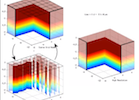Ocean convection
In a series of papers – [19], [20], [27], [32], [33], [34], [36], [40], [42], [reviewed in [50], I explored the mechanism of open-ocean deep convection in which the properties of large volumes of water are changed by air-sea interaction and subducted into the interior of the ocean. Observational, laboratory, and modeling studies of ocean convection were pursued, which revealed a fascinating and complex interplay of convective and geostrophic scales, the large-scale circulation of the ocean, and the prevailing meteorology. Two key aspects were drawn out by these studies. First, the timescale of deep convection in the ocean is sufficiently long that it may be modified by the Earth’s rotation; second, the convective process is localized in space so that vertical buoyancy transfer by upright, non-hydrostatic convection can give way to slantwise transfer by baroclinic instability in balanced, geostrophic motion. Moreover, in the ocean – and unlike in the atmosphere – the convective and geostrophic scales are not very disparate from one another [50].
My group was the first to carry out detailed numerical calculations of open-ocean convection, which simultaneously resolved the convective and geostrophic scales and exposed their interplay in an idealized setting [19], [20]. These ideas now form the basis of the paradigm in which the community thinks about deep convection. Powerful scaling laws were advanced and supported by numerical and laboratory study and physical argument, which addressed the dominant space, velocity and buoyancy scale of open-ocean convective plumes and the geostrophically adjusted end-state of the convective process. It displaced the conventional view that convection in the ocean is like (dry) convection in the atmosphere, but upside down. The research suggested new ways of parameterizing convectively-driven mixing and lateral exchange in the large-scale models used for climate research. Moreover, our work drove a major field program, the Labrador Sea Deep Convection Experiment [42], which involved scientists from numerous backgrounds, nationalities and skills. This project provided the most comprehensive set of measurements of ocean convection ever collected, securing valuable knowledge about the Labrador Sea, a central player in, and sensitive indicator of, climate variability and change.



